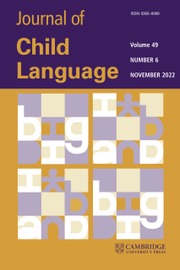Article contents
Delayed acquisition of non-adjacent vocalic distributional regularities*
Published online by Cambridge University Press: 19 March 2015
Abstract
The ability to compute non-adjacent regularities is key in the acquisition of a new language. In the domain of phonology/phonotactics, sensitivity to non-adjacent regularities between consonants has been found to appear between 7 and 10 months. The present study focuses on the emergence of a posterior–anterior (PA) bias, a regularity involving two non-adjacent vowels. Experiments 1 and 2 show that a preference for PA over AP (anterior–posterior) words emerges between 10 and 13 months in French-learning infants. Control experiments show that this bias cannot be explained by adjacent or positional preferences. The present study demonstrates that infants become sensitive to non-adjacent vocalic distributional regularities between 10 and 13 months, showing the existence of a delay for the acquisition of non-adjacent vocalic regularities compared to equivalent non-adjacent consonantal regularities. These results are consistent with the CV hypothesis, according to which consonants and vowels play different roles at different linguistic levels.
Information
- Type
- Articles
- Information
- Copyright
- Copyright © Cambridge University Press 2015
Footnotes
This study was conducted with the support of a CONACYT grant to NGG, and ANR-13-BSH2-0004 and LABEX EFL (ANR-10-LABX-0083) grants to TN. Special thanks to the infants and their parents for their kindness and cooperation.
References
REFERENCES
- 3
- Cited by


